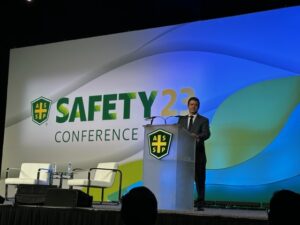Heat stress and fall prevention continue to be among the major focus areas for the Occupational Safety and Health Administration (OSHA) this year, but a new focus is mental health. Speaking last week at the American Society of Safety Professionals’ (ASSP) Safety 2023 conference, Assistant Secretary of Labor for Occupational Safety and Health Doug Parker said American workers are under serious mental duress.
“We have a crisis in this country where people are isolated, they’re alone, they are suffering,” he said. “I think we have to recognize that the workplace has a role in mitigating that tragedy.”
OSHA’s Safe + Sound campaign this year is going to be focused on mental health, Parker said.
“We have a mental health crisis in this country in the workplace,” he added. “The stat that I find most startling is one in construction where we have per year the equivalent of out of 100,000 full-time workers, just north of eight of those workers died from traumatic injury in the workplace. Studies show the number that die from suicide is conservatively five times that, 45-55.”
The impact reaches beyond the personal, Parker noted.
“Not only is it important for basic personal reasons, for basic humanity, it’s [also] critical because this has a direct impact on health and safety,” he said. “People’s awareness, people’s stress, the presence they’re bringing to work…it all has a factor in having an effective business and effective health and safety.”
Parker said he is already seeing encouraging feedback from the industry. “I greatly appreciate how many employers just get it and agree with us that this is something we can all come together on and make a difference.”
Parker also outlined the status of other OSHA initiatives:
- Heat safety. “We’re increasing our efforts in the area of heat hazards in both outdoor and indoor environments,” he said. OSHA launched a National Emphasis Program (NEP) on heat safety last year and “did more than 1,700 NEP inspections last year and more this year.” A proposed rule on heat illness prevention received many great comments from the public; the next step is to gather small business input. The first heat fatality of 2023 occurred on New Year’s Day in Florida, Parker added. “The risk factors start to present at much lower temperatures than realized.”
- Fall prevention. Last month, OSHA announced an NEP for falls from height across all industries. Parker said falls continue to be the leading cause of workplace deaths in this country. “We provide flexibility to identify fall hazards in a strategic way,” he added. “We need to be more present in places like residential construction…There’s going to be a larger degree of scrutiny in those areas.”
- Workplace violence prevention. There are multiple types of workplace violence: Criminal, customer, interpersonal relationship violence. Parker said there are many differences depending on the setting, but the main focus is on healthcare. Facilities should look into staffing levels, conduct risk assessments with patients, and consider line of sight, panic buttons, and barriers. In other settings, employers should harden external security and access, he added.
- Diversity, equity, and inclusion in the workplace. Parker said OSHA held a workers’ voice summit last fall to get people’s stories about equity. The highest fatality rates in the country are among Latino and Hispanic workers. “We see that workers will not talk to us if they believe their employer will retaliate against them,” he said. “It’s not enough to be well intentioned…it’s an expectation that we have.”
- Trench and excavation safety. Asked about OSHA’s efforts in trench safety, Parker said the agency isn’t working on any new initiatives, but inspectors are watching for it. Last year, there were 35 deaths from trench and excavation hazards. “We are going to really emphasize trenching in our inspections,” and will evaluate the cases for criminal referral, he said. So far this year, Parker said, he’s aware of six fatalities, down from 17 halfway through last year.

